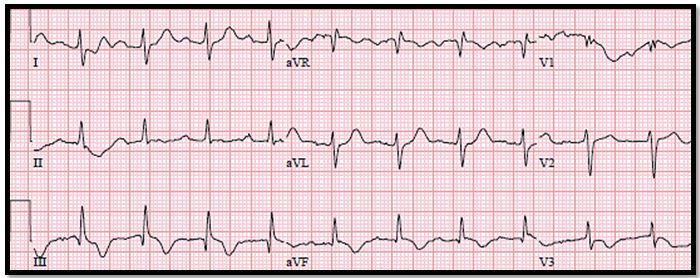- CDC
- Heart Failure
- Cardiovascular Clinical Consult
- Adult Immunization
- Hepatic Disease
- Rare Disorders
- Pediatric Immunization
- Implementing The Topcon Ocular Telehealth Platform
- Weight Management
- Monkeypox
- Guidelines
- Men's Health
- Psychiatry
- Allergy
- Nutrition
- Women's Health
- Cardiology
- Substance Use
- Pediatrics
- Kidney Disease
- Genetics
- Complimentary & Alternative Medicine
- Dermatology
- Endocrinology
- Oral Medicine
- Otorhinolaryngologic Diseases
- Pain
- Gastrointestinal Disorders
- Geriatrics
- Infection
- Musculoskeletal Disorders
- Obesity
- Rheumatology
- Technology
- Cancer
- Nephrology
- Anemia
- Neurology
- Pulmonology
Hypoxia in an Elder
The 82-year-old is observed to be in respiratory distress but denies any symptoms. See the ECG for more information. Your dx?
Computer ECG (please click to enlarge)

ECG changes in PE (please click to enlarge)

History of present illness
An 82-year-old woman with a history of dementia but no pulmonary history is sent to the emergency department (ED) for hypoxia. Yesterday at her nursing facility she had no complaints, but was noted to be hypoxic-oxygen saturation (SaO2) 83% on room air with a temperature of 99° F. Levofloxacin (Levaquin) was initiated out of concern for pneumonia. Tonight she experienced sudden respiratory distress with SaO2 of 74% on room air, and so was sent to the ED. She denies being short of breath as well as any other symptoms, but seems to be an unreliable historian.
Vital signs, physical examination
- Temp: 97.7 °F
- Heart rate: 85 beats/min
- Respiratory rate: 24 breaths/min
- Blood pressure: 84/52 mmHg
- SaO2: 92% on 15L/min oxygen by face mask
Physical examination is notable for moderate respiratory distress with bilateral wheezing and prolonged expirations as well as bilateral rales. Also noted are mild to moderate peripheral edema and disuse atrophy in both legs.
Initial differential diagnosis
- Dysrhythmia
- CHF
- COPD
- Pneumonia
- Pulmonary embolism (PE)
Initial diagnostic testing
- Laboratory study results are pending
- Chest x-ray shows pulmonary edema
- ECG tracing shown in Figure 1, above right (please click to enlarge)
Computer ECG read
Normal sinus rhythm, inferior ischemia, possibly acute
Do you agree?
Please click here for answer, discussion, case conclusion
Answer
The computer read is accurate. The ECG does show deep T-wave inversion in 2 of 3 inferior leads, which is consistent with ischemia; it is not specific, however, for cardiac ischemia. The ECG also shows a borderline elevated pulse at 96 beats/min with an S1Q3T3 pattern (S wave in lead 1 and Q and T waves in lead 3). When compared to results of a prior ECG, all of these findings were new.
Discussion
Acute pulmonary embolism (PE) can produce a variety of ECG changes. S1Q3T3 is perhaps the most famous, but it is not that common, occurring in only about 12% of PEs. It is probably infamous because it is associated primarily with large PEs, the ones that are more likely to be fatal. The top 5 ECG findings in PE can be remembered by The 5 Ts:
- Inverted T wave: 35%
- Flat T wave: 30%
- Tachycardia: 25%
- Totally normal: 15%
- S1Q3T3: 12%
Of the S1Q3T3 triad, the Q3 and T3 are both not infrequent normal variants. The deep S wave in lead 1 is the most important component and is the result of right heart strain, which requires a fairly large PE. It is useful also to know the 4 main causes of an acute right axis: PE, hyperkalemia, tricyclic overdose, and lead reversal. Whenever you see a right axis or ECG computer read of “pulmonary disease pattern” and it is new, PE should jump to the top or at least near the top of your differential diagnosis. Other important ECG findings in PE are listed in the highlighted area of the sample page in the image at right, above (please click image to enlarge).
Case conclusion
Laboratory findings included elevated BNP and white blood cell count. The patient was treated for CHF and bronchospasm, the latter related to CHF and not COPD, as well as for possible pneumonia. She was also evaluated for a PE. Duplex ultrasound of the legs was positive so she was started on heparin. TPA was considered but not given as vital signs were improving. She was admitted to the ICU with plan for VQ (ventilation-perfusion) scan or CT angiography of the chest once her renal function improved (creatinine was acutely elevated).
For additional information, please see full excerpt on EKG Changes in PE from The Emergency Medicine 1-Minute Consult pocketbook
